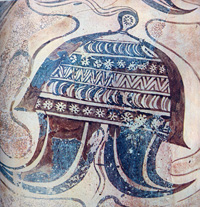 |
The Greek Age of Bronze
Early Helmets |
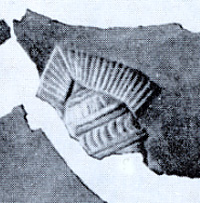 |
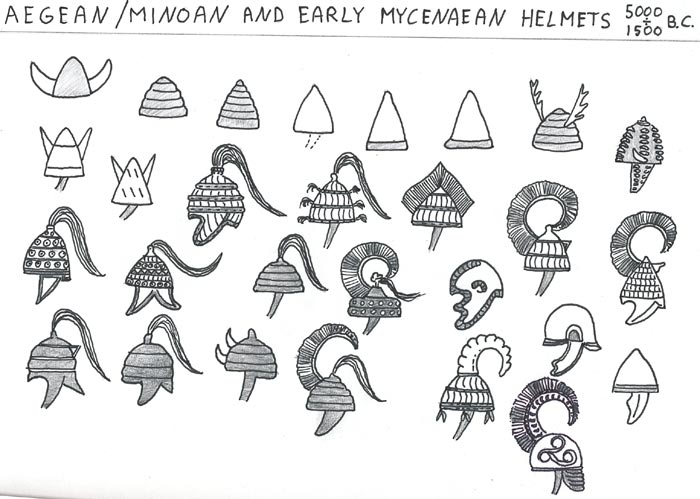 Aegean/Minoan and early Achaean helmets 5000-1500 BC Based on pottery, fresco, sculpture representations and partial findings. Aegean/Minoan and early Achaean helmets 5000-1500 BC Based on pottery, fresco, sculpture representations and partial findings. |
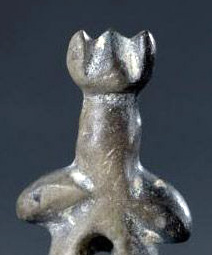 |
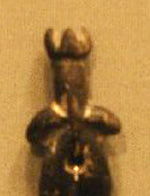 |
Two very early representations of possible helmets or caps probably decorated with horns are attested in the Greek mainland since the Neolithic period as shown in these stone amulets from Sesklo dated between 5300-4500 BC. This kind of conical cap or early helmet was more likely made of leather with decorative long horns. |
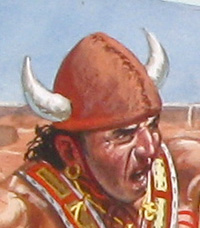 |
| Other possible evidence of Aegean helmets are also present in the Early Cycladic culture. In some marble male and female figures dated between 3200-2800 BC from Plastiras and Louros horizontally ribbed, conical-shaped caps are represented, which are probably to be understood as helmet probably made of leather or linen. |
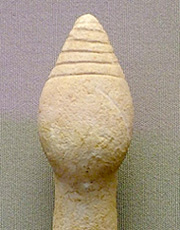 |
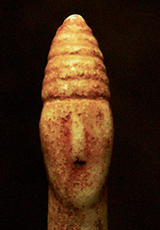 |
| Similar conical helmet is probably represented in one of the simbols of the famous, still undeciphered, Phaistos disk dated 2000-1700 BC |
 |
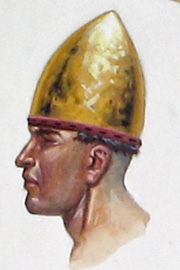 |
 |
Some pieces of Trojan helmet's crests probably dated around 2000 BC have been found by Henry Schliemann in a room of the palace in the Isarlik hill settlement. Because the close commercial trade between the Anatolian and the Aegean populations these pieces are worth mentioning as elements of early type of East Mediterranean helmet. |
| On his excavation report Henry Schliemann also describes other similar pieces and fragments as crest-decorations and crest-holder probably part of at least another similar helmet. Even if no futher informations are given, a reasonable reconstruction of these early Trojan helmets can be hypothize.
|
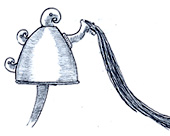 |
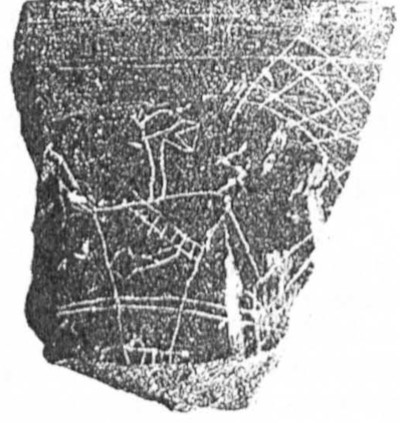 |
The motif' of a male individual wearing a cap or helmet, a baldric and a weapon is not unique to the central and southern Aegean. Like in this pottery fragment from Troy II. |
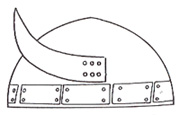 |
Boar tusks more likelly used as reinforcement or decorative elements of a cap-helmet dated around 2000 BC have been found in Mariupol Ukraine. This very primitive boar tusks helmet gives evidence as this style of reinforcements and decorations was probably introduced in the Aegean world by the Indoeuropean population migrate from the central and north Europe areas around 2000-1800 BC. These populations spreaded all over the Greek mainland and mixed with the early native greeks becomed the Acheans people. |
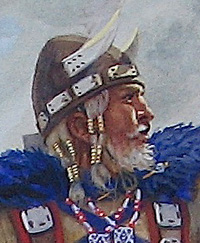 |
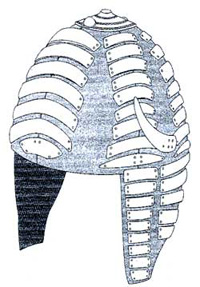 |
In a shaft greave dated around MH II (about 1800 BC) in Kolonna Aegina remains of a very interesting helmet have been found. Several boar tusks in different shape and an upper element were reinforcement parts of a perishable material helmet. This model was more likely the ancestor of the typical Achaean and Minoan boar tusks helmets. |
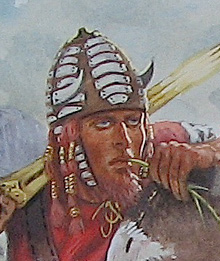 |
| Boar tusks helmets are wear by the warriors depicted in the fresco dated around 1600 B.C. from Akrotiri in Thera island. These helmets have horse tail and seem to be decorated in the frontal and back sides with unidentified elements, probably feathers. The throat strap is also visible.
|
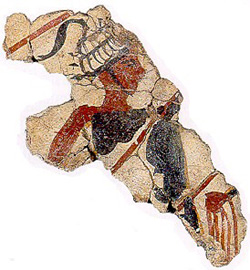 |
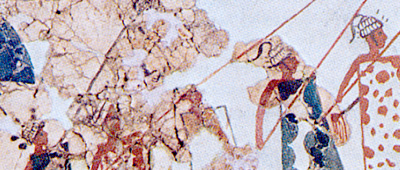 |
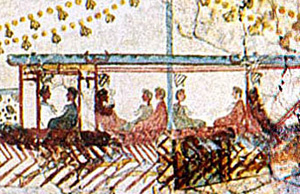 |
Similar helmets seem also represented in another fresco from Akrotiri. In the as-called "Naval festival" one ship seems equipped with boar tusks helmets hanging from the passengers cabin. Any ship was more likely equipped with some weapons to be used by the crew or passengers in case of attack by hostile populations or pirates. |
| Conical horned helmets are represented on some Minoan linear sign which, in a semi-pictorial form, already appears on inscribed clay bars of Mallia, going back to the earliest phase of MM III (about 1600 BC). These representations already show traces of the chin straps, and the rows of boars' tusks have left their traces in the case of image b.
|
 |
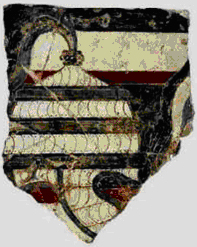 |
A very interesting and elaborate boar tusks helmet with large cheek guards is also represented in another fresco fragment from Akrotiri always dated around 1600 BC. |
| A possible boar tusks helmet is also represented in a seal stone from Ayia Triada Crete dated MM III (about 1600 BC).This helmet shows a large curved crest and some pendants around the lower edge.
|
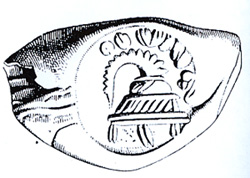 |
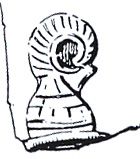 |
A boar tusks helmet with a large circular crest is also represented on a "rhyton" fragment from Knossos dated around MM IIIB-LM I (about 1600-1550 BC). |
| Different type of crested boar tusks helmets are shown in the silver "ryton" from shaft-grave IV in Mycenae dated LH IB (about 1550 BC). |
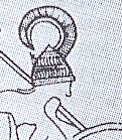 |
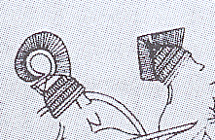 |
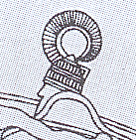 |
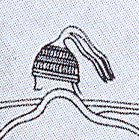 |
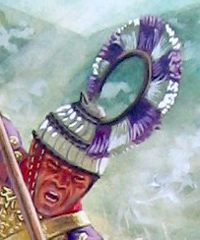 |
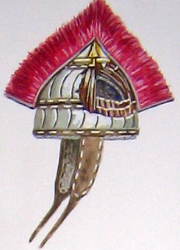 |
These helmets were made of perishable material more likely leather and felt on which were sewed horizontally rows (from two to five) of boar tusks plates. The plates were placed with the curved side on the right and on the left on alternatively rows. The upper plates had a triangular shape, on the top of the helmet a circular button made of ivory or bronze were placed sometimes used as crest holder. |
| Several worked boar tusks and ivory upper part elements of helmets have been found in the same shaft-grave IV. The upper parts clearly show the crest holder fixation opening in which remains of wood were still present. The most elaborate types of these helmets were more likely used by high rank warriors being necessary at least twenty to forty boars to made an elaborate helmet. |
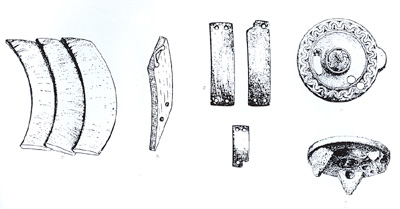 |
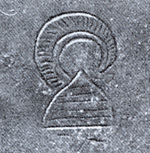 |
Similar type of helmet is also represented in a bronze axe from Crete dated around LM II (about 1500 BC). |
| In particulary these types of Cretan boar tusks helmets were also equipped with large neck and cheeks guard probably made of leather or bronze. A composite helmet made of boar tusks with bronze element has been also found in the tomb n. 12 of Dendra (see the page dedicated to the middle period helmets). The boar tusks helmets have been utilized during all the Greek Bronze Age periods (see also the pages dedicated to the middle and late period helmets) and are also attested in the Iliad (*1) |
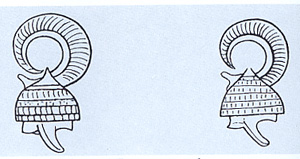 |
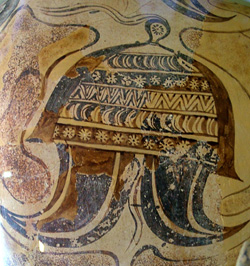 |
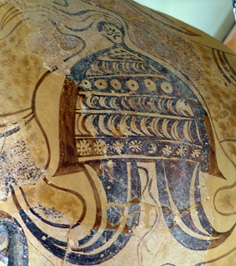 |
Two interesting helmets with cheek and neck guards are represented on a vase from Katsamba Crete dated around LM II (about 1500 BC). These helmets were more likely reinforced and decorated with rows of boar tusks and small rosettes which could have been made of ivory or metal. The upper knob with relevant horse tail is also visible. |
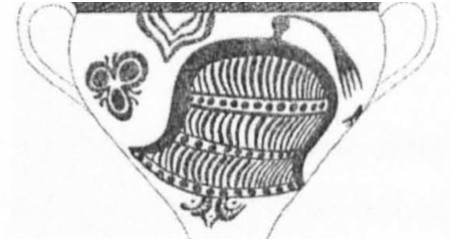 |
A LM II goblet was found at Knossos with a depiction of' a boar's tusk helmet; Three zones of tusks and a knob with plunics can be seen. |
| An ivory relief from Phaistos Crete XVI Century BC, represents a conical helmet with small cheek and neck guards. Also in this case the reinforcement disks were probably made of ivory or metal. |
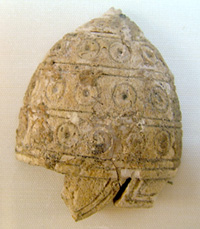 |
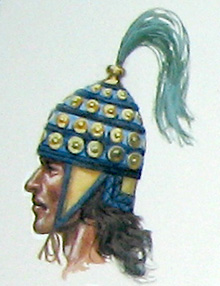 |
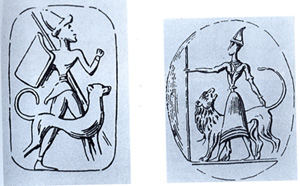 |
High conical helmets with a lower padded edge are attested in Crete as shown in these two seals from Knossos dated around MM III (about 1600 BC). Similar helmets are also represented in seals from Zakro and Haghia Triada as well as in a bronze figure from Iraklion dated around LH I (about 1550 BC). |
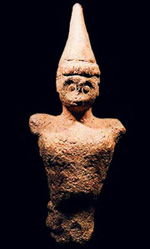 |
Similar High conical helmet or cap is also represented in this sculpture from Crete dated around 2000-1900 BC. |
| On a famous "ryton" from Haghia Triada dated LM I three boxers are represented with low profile "hollow-eyed" helmets with long curved cheek guards and ears opening. Even if the helmets used in this boxing scene were more likely made of leather or other perishable material, because their general design we can't exclude that bronze versions of similar helmets were also utilized in warfare. |
| 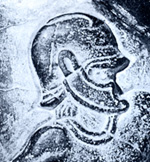 |
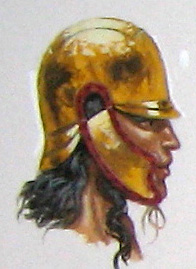 |
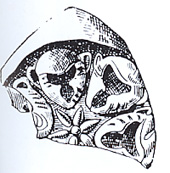 |
Low profile "Hollow-eyed" helmets seem also represented on this seal fragment from Zakro Crete dated around MM III. |
|
| In the Greece mainland similar helmet is attested in Pylos being reproduced on a gold pendant dated around MH III found under the room n° 97 of the palace. Also in this case the helmet could have been made in leather reinforced on the rims or in bronze with the internal linen sewn all around the helmet edges.
|
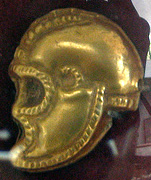 |
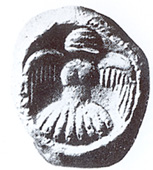 |
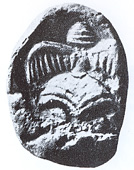 |
Another very common type of helmet, more likely made of leather or felt hood as thick padding sewn together at intervals, was the conical one with concentric bands "beehive" style. Different variant of these helmets have been identified, with or without cheek and neck guards, in some case upper knob, horse tail and crest were present as well as horns. These helmets has been attested both in Crete and in Greek mainland. The two seals from Zakro Crete dated around LM I (about 1550) show the simplest variant of these helmets. In this case the helmets are represented together a probable deity "eagle-lady". |
|
| A similar helmet seems represented in this seal from Knossos dated around MM III. Two small horns (more likely deer's horns) are also depicted as decorative element of this simple conical padding helmet.
|
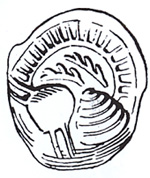 |
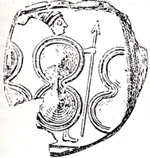 |
Found in Knossos is another seal, probably coming from the last palatial period, with a warrior placed between two shields in figure-of-eight. This warrior is armed with spear, shield and a conical padded bands helmet with a long horse tail. |
| The tholos tomb from Kephala dated LM I (about 1550 BC) revealed the fragment of an ivory plaque bearing a small part of a highly interesting relief with two helmets. The one on the left seems padded or coverd with boar tusks. The one on the right, mostly coverd by a possible large body shield, has an upper tube with plumes.
|
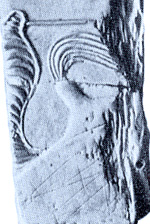 |
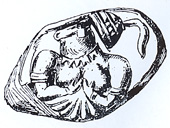 |
From Zakro is another seal dated LM IA or LM IB representing a strange deity with equine head and a conical bands helmet with horse tail. |
|
| Probably from Crete is also this seal representing some weapons and a conical padded bands helmet with two upper curved crest or horns. Also this findig more likely is from the last palatial period. |
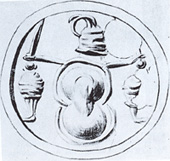 |
| A conical padded and crested helmet is also well represented in this lentoid bead-seal from unknown provenace probably dated 16th Century BC |
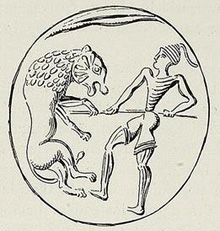 |
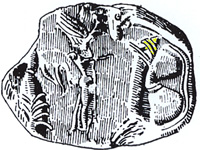 |
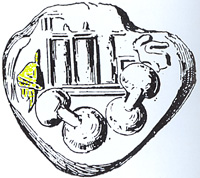 |
From Zakro are these two seals dated around LM IA or LM IB. In the first one a conical bands helmet with cheek guards is depicted over the tower shape shield. In the second one the conical helmet with cheek guards and upper tube seems to be padded only in the lower rim.
|
| Similar conical helmets with cheek guards but in this case equipped with large crest and plumes are depicted in this sealing from Ayia Triada Crete also dated LM IA or LM IB.
|
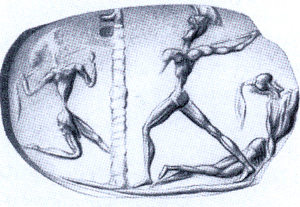 |
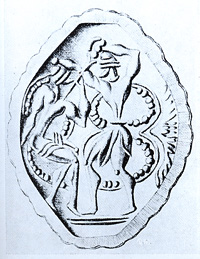 |
The conical bands padded helmet is well represented also in Greece mainland. In this seal from greave III of the circle A shaft-greave in Mycenae the two warriors are equipped with conical helmets with padded bands and cheek guards. |
|
| In another seal fron the same grave the warrior on the right side is equipped with an elaborate bands helmet. It seems compoused by two large padded bands more likely reinforced with metal disks, an upper decorated knob with horse tail and a large circolar crest similar to the ones placed on some boar-tusks helmets of the same period. |
| 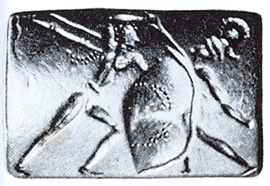 |
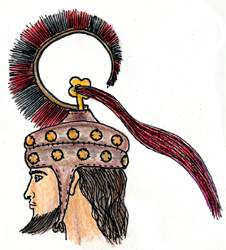 |
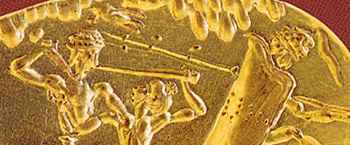 |
Padded and decorated helmets with horse tail are worn by the two warriors on the gold ring from the shaft-grave IV in Mycenae dated LH IB. |
|
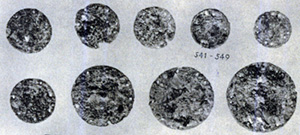 |
Several bronze discs with fixation holes have been also found in the shaft-grave IV in Mycenae. Because these elements have been found together helmet parts like the boar tusks and the ivory upper knots, these discs are more likely to be intended as reinforcement/decorative elements of some kind of perishable material helmets |
|
| On the silver "rhyton"coming from the same grave one of the warriors seems to wear a padded conical helmet. |
| 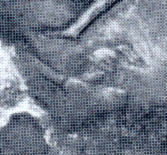 |
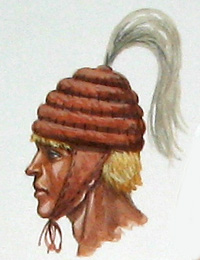 |
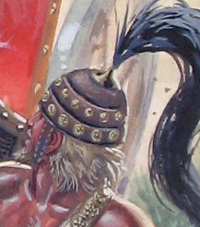 |
Based on the above representations and findings reasonable padded conical helmets made of perishable material and sometimes reinforced or decorated with bronze discs can be hypotize. |
|
| On a "Faience" vase fragments from Mycenae dated 16th Century BC two conical padded helmtes are identifiable. These helmets have small horns probably made of boar-tusks and an upper knob. a neck protection and the throat strap are also visible. |
| 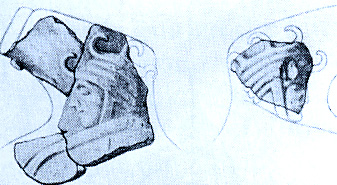 |
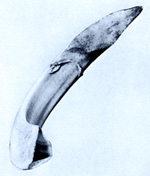 |
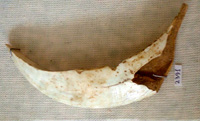 |
The usage of horns as decorative/protective elements in some type of Achaeans helmets is well attested in several images as well as findings. The helmets' horns utilized in all the Late Helladic period were normally made with boar-tusks, deer horns, ivory as well as metal like the two lead horns found in Dendra (see also the pages dedicated to the helmets of the middle and late period). |
|
| Two objects of ivory in the form of ram's horns have been also found in one of the shaft-grave in Mycenae dated LH IB (about 1550 BC). |
| 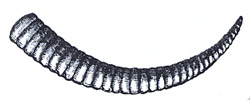 |
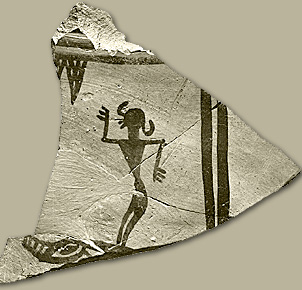 |
A possible sailor or warrior wearing a conical horned helmet is represented in this pottery painting from Aegina dated around 1600 BC. |
|
| A clear representation of a padded conical helmet with neck protection, large throat string and horse tail is from a marble fragment from the island of Keos dated around 1450 BC. |
| 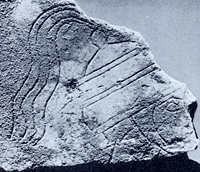 |
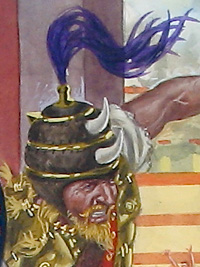 |
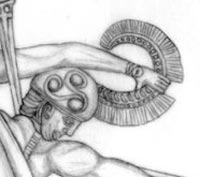 |
A very awesome representation of a embossed decorated helmet without closer parallels has been found on a Minoan or early Achaean seal in a rich warrior grave in Pylos dated around 1500-1420 BC. The helmet dome appears to be made of bronze with decorations in relief. It also has an high circolar crest and a neck flap at the back which may be an extension of a leather internal padding.(*2) |
| Some bronze bands and gold decorations from a grave in Routsi Messenia dated from 16th to 15th Century BC have been interpreted as possible metal reinforcement of a perishable material helmet. |
| 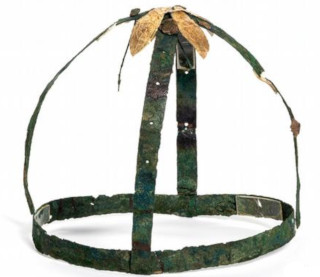 |
| CONCLUSION
|
| One of the most distinctive element of the early Aegean weaponry is the helmet which is attested since the early Cycladic culture. During the first periods of the Late Helladic time different type of helmets were used in Greek mainland and in the Aegean Islands. mostly these helmets were made of leather or felt even if the presence of similar variant in bronze or copper can't be excluded. One of the most famous and characteristic type of Greek Bronze Age helmet was the conical one made of leather reinforced with rows of boar-tusks. This particular helmet seems to be introduced in the Aegean area by the populations migrate in the Greek mainland from Central/North Europe around 1800 BC. Because the high number of boar-tusk necessary to made an helmet (twenty to forty boars) the most elaborate ones were probably utilized by medium/high rank warlords. Another common type of helmet was the conical one normally made of leather or felt hood as thick padding sewn together at intervals. Some of these helmets, as well as for the one reinforced with boar-tusks, were decorated with crest, horse tail, horns and sometimes equipped with neck protection and cheek guards. Some composite helmets with parts made of leather, boar-tusks, ivory and bronze elements were also utilized in this period. Furthermore both in Crete than in Greek mainland a particular type of low profile helmets with "hollow-eyed" was also used.
|
(*2) Sharon R. Stocker and Jack L. Davis, The Combat Agate from the Grave of the Griffin Warrior at Pylos; Hesperia: The Journal of the American School of Classical Studies at Athens (2017).
|
|